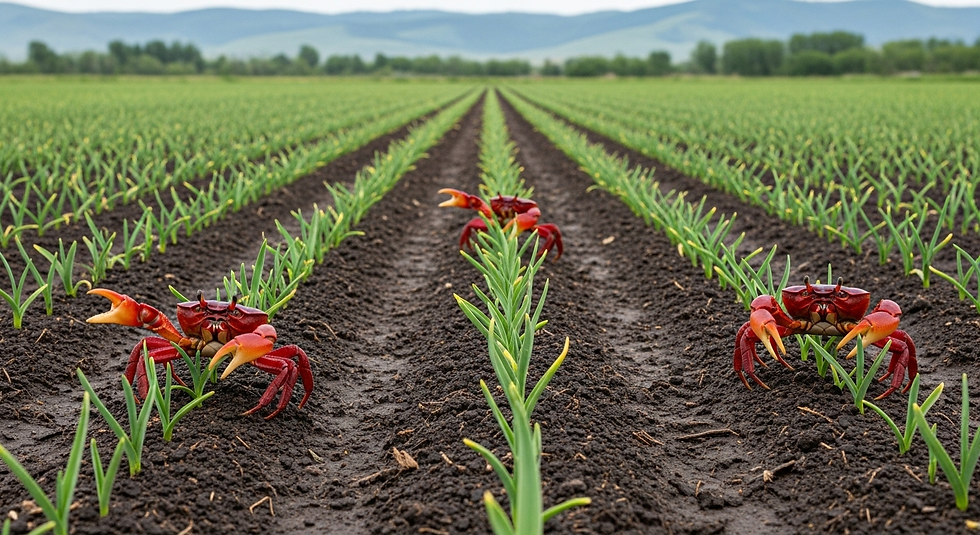Tillage Radish Cover Crop
- Jere Folgert
- Mar 4, 2018
- 4 min read
Updated: Mar 22, 2023
Tillage Radish Cover Crop
Raphanus sativus
Tillage radish is the perfect crop for breaking up hardpan soils or improving tilth in workable but heavy soils. It is similar to a daikon radish, with big, strong roots that plunge deep into the soil. Sown in late summer, it forms these giant roots and is then winter killed, which turns the roots into mush as the soil thaws. After a few weeks, the root mush starts to dry up, leaving behind air channels that help establish deeper tilth and dramatically increase the surface area of the soil that is exposed to air, allowing the soil to dry out more quickly—especially helpful in wet springs.
Tillage radishes are a type of cover crop that is grown to improve the soil and reduce erosion. They are typically planted in the fall and harvested in the spring. Tillage radishes have a deep taproot that helps to break up compacted soil and improve drainage. They also release nutrients into the soil as they decompose.
Tillage radishes can be used in a variety of ways. They can be planted between rows of crops to help reduce erosion and improve water infiltration. They can also be planted in a field that is not being used to grow crops. This will help to improve the soil and provide nutrients for the next crop that is planted.
Tillage radishes are a valuable tool for farmers who are looking to improve their soil and reduce erosion. They are easy to grow and provide a number of benefits.
Here are some of the benefits of using Tillage Radish Cover Crop:
Improves soil structure. Tillage radishes help to break up compacted soil and improve drainage. This makes the soil more friable and easier for roots to penetrate.
Reduces erosion. Tillage radishes help to hold the soil in place and reduce erosion. This is especially important in areas with high rainfall or wind.
Increases water infiltration. Tillage radishes help to improve water infiltration into the soil. This helps to prevent water from running off the surface and causing erosion.
Provides nutrients. Tillage radishes release nutrients into the soil as they decompose. This helps to improve the fertility of the soil.
Suppresses weeds. Tillage radishes can suppress weeds by competing for sunlight and nutrients. This makes it easier for crops to grow.
If you are looking for a way to improve your soil and reduce erosion, Tillage Radish Cover Crop is a great option. It is easy to grow and provides a number of benefits.

The Tillage Radish has been proven to increase yields. University tested and proven over 10 years. Tillage Radish® are similar to oilseed radishes, but have a larger, deeper penetrating tap root to aid as a biological tool to reduce soil compaction. Tillage Radish® are best planted in the fall at least 4-10 weeks before the first killing frost. Tillage Radish® germinate rapidly and start covering the ground within few days. While growing, Tillage Radish® scavenge nutrients such as nitrogen, phosphorous and calcium from deep within the soil profile, making them more readily available for the next crop. Tillage Radish do best with about 60 lbs Nitrogen (residual or applied) at seeding to promote growth. This nitrogen will be retained and released for the next crop. Great for weed suppression on weeds like henbit and chickweed. Helps suppress nematodes.Goes deeper in the soil profile than a deep ripper and best of all it doesn’t bring up any rocks! Available in 50 lb bags or 2000 lb totes. Seeding rate 10-12 lbs/acre broadcasted, 6 lbs/acre drilled, 2-4 lbs/acre in cover crop mixes, 4 lbs/acre precision planted.
Although the root is the most widely utilized part of this crop, don't forget about the green leaves as they offer a wide range of health benefit as well. In Asian countries, daikon radish root is commonly pickled and eaten as a side dish or added to main dishes, grated, cubed or in thin slices. Are you in to sprouts? Enjoy daikon sprouts (called "kaiware" by the Japanese), which have a pungent and peppery flavor that adds a kick to sandwiches and salads. You don't even have to cook them as daikon sprouts are best eaten raw since they are very delicate and can be damaged by heating. Plant daikon radish seeds to obtain high amounts of potassium, vitamin C and phosphorus which as you know are all very good for you.
Fracking Daikon Radish is a deep rooted forage radish that will make an outstanding winter cover crop. The deep taproot of the large rooted plant can help break up the tough, compacted soil, improve water infiltration, suppresses weeds, eliminate pests and stores nitrogen. When planting daikon radish seed as a cover crop, the benefits will be optimized if planted in late summer:
Reduces soil compaction
High Biomass production
Increases water infiltration
Excellent erosion control
Great weed suppression
Fast establishment


